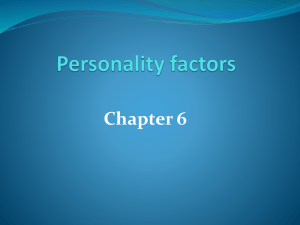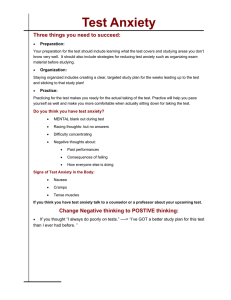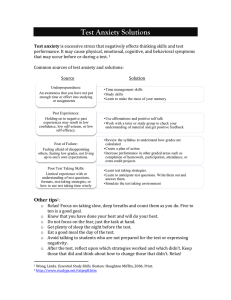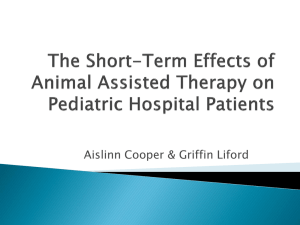Document 14093333
advertisement
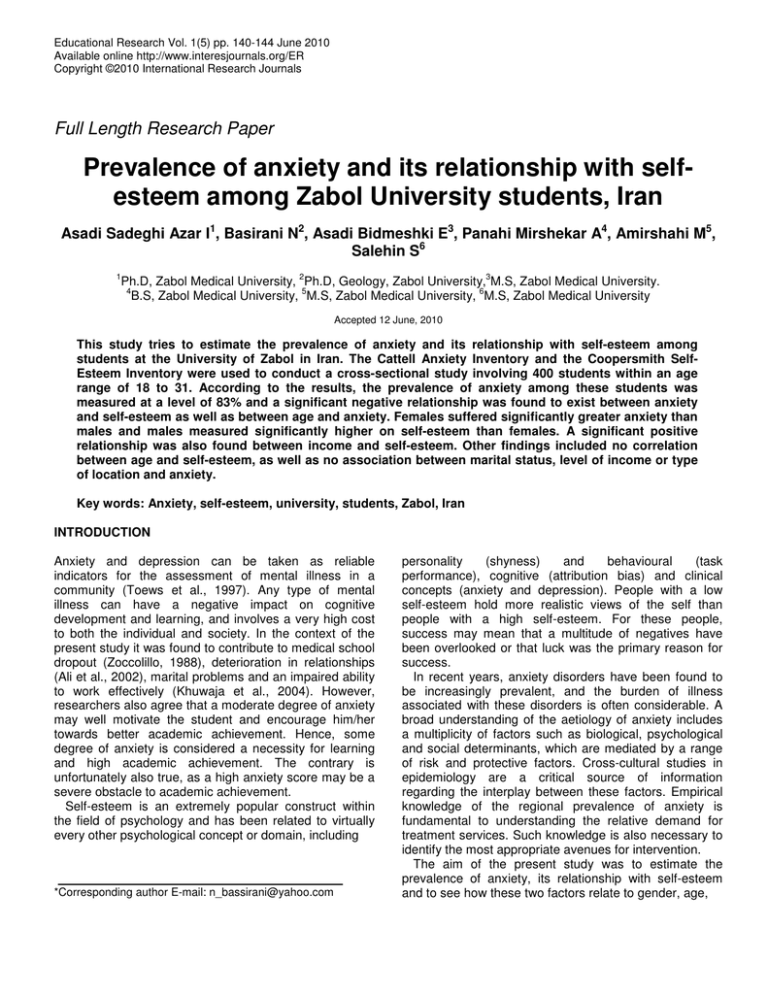
Educational Research Vol. 1(5) pp. 140-144 June 2010 Available online http://www.interesjournals.org/ER Copyright ©2010 International Research Journals Full Length Research Paper Prevalence of anxiety and its relationship with selfesteem among Zabol University students, Iran Asadi Sadeghi Azar I1, Basirani N2, Asadi Bidmeshki E3, Panahi Mirshekar A4, Amirshahi M5, Salehin S6 1 2 3 Ph.D, Zabol Medical University, Ph.D, Geology, Zabol University, M.S, Zabol Medical University. 4 5 6 B.S, Zabol Medical University, M.S, Zabol Medical University, M.S, Zabol Medical University Accepted 12 June, 2010 This study tries to estimate the prevalence of anxiety and its relationship with self-esteem among students at the University of Zabol in Iran. The Cattell Anxiety Inventory and the Coopersmith SelfEsteem Inventory were used to conduct a cross-sectional study involving 400 students within an age range of 18 to 31. According to the results, the prevalence of anxiety among these students was measured at a level of 83% and a significant negative relationship was found to exist between anxiety and self-esteem as well as between age and anxiety. Females suffered significantly greater anxiety than males and males measured significantly higher on self-esteem than females. A significant positive relationship was also found between income and self-esteem. Other findings included no correlation between age and self-esteem, as well as no association between marital status, level of income or type of location and anxiety. Key words: Anxiety, self-esteem, university, students, Zabol, Iran INTRODUCTION Anxiety and depression can be taken as reliable indicators for the assessment of mental illness in a community (Toews et al., 1997). Any type of mental illness can have a negative impact on cognitive development and learning, and involves a very high cost to both the individual and society. In the context of the present study it was found to contribute to medical school dropout (Zoccolillo, 1988), deterioration in relationships (Ali et al., 2002), marital problems and an impaired ability to work effectively (Khuwaja et al., 2004). However, researchers also agree that a moderate degree of anxiety may well motivate the student and encourage him/her towards better academic achievement. Hence, some degree of anxiety is considered a necessity for learning and high academic achievement. The contrary is unfortunately also true, as a high anxiety score may be a severe obstacle to academic achievement. Self-esteem is an extremely popular construct within the field of psychology and has been related to virtually every other psychological concept or domain, including *Corresponding author E-mail: n_bassirani@yahoo.com personality (shyness) and behavioural (task performance), cognitive (attribution bias) and clinical concepts (anxiety and depression). People with a low self-esteem hold more realistic views of the self than people with a high self-esteem. For these people, success may mean that a multitude of negatives have been overlooked or that luck was the primary reason for success. In recent years, anxiety disorders have been found to be increasingly prevalent, and the burden of illness associated with these disorders is often considerable. A broad understanding of the aetiology of anxiety includes a multiplicity of factors such as biological, psychological and social determinants, which are mediated by a range of risk and protective factors. Cross-cultural studies in epidemiology are a critical source of information regarding the interplay between these factors. Empirical knowledge of the regional prevalence of anxiety is fundamental to understanding the relative demand for treatment services. Such knowledge is also necessary to identify the most appropriate avenues for intervention. The aim of the present study was to estimate the prevalence of anxiety, its relationship with self-esteem and to see how these two factors relate to gender, age, Asadi et al. 141 marital status, residential area and economic status among students enrolled at the University of Zabol. METHOD AND PROCEDURE A cross-sectional study was conducted on a sample of 400 students enrolled at the University of Zabol, a city in the southeastern region of Iran. The samples were taken from the classes that were doing general courses. In these classes students of both sexes, various ages, differing marital status and different income levels were mixed. Two standardised questionnaires (one for anxiety and one for self-esteem) and a sheet containing demographic variables were used to assess anxiety and selfesteem, as well as related demographic variables. The researcher calculated the relative risk for each statistically significant risk factor. Significant risk factors were then analysed using log-linear models, multidimensional 2 tests, a one-way analysis of variance (ANOVA) and the Pearson correlation coefficient. Post-hoc t-values were computed for the variables that yielded significant F-values. The researchers determined that p-values at the levels of 0.05 and 0.01 would be considered statistically significant. Description of the tools The Cattell Anxiety Inventory is a 40-item self-report measure of anxiety. A translated and validated Persian (Farsi) version was used in this study (Alvandi, 1988). Scores can range from 0 to 80, with scores of 28 or above demonstrating anxiety. A classification of the range of possible anxiety scores is 0-27 (without anxiety); 28-40 (moderate anxiety); 41-49 (neurotic anxiety), and 50-80 (severe anxiety). The Coopersmith Self-Esteem Inventory (CSEI) (Coopersmith, 1975) was designed to measure attitudes toward the self in personal, social, family and academic areas of experience. The original CSEI (School Form) was constructed to measure selfesteem in children. Most of the 50 self-esteem items in the School Form were adapted from scale items used by Rogers and Dymond (1954) in their classic study of nondirective psychotherapy. The Self-Esteem Inventory (SEI) Adult Form was adapted from the short form for use with persons over fifteen years of age. The Adult Form consists of 25 items, most of which are based on items selected from the School Short Form. With 25 items, the possible scores range from 0 to 25, and the obtained score is then multiplied by 4. The maximum possible total score is 100. A lower score points to a lower self-esteem while a high score implies a high self-esteem. Test-retest reliability for the SEI was originally reported by Coopersmith (1967) to be 0.88 for a sample of 50 children in grade V and 0.70 for a sample of 56 children who were 12 years old. According to Tabatabaei Yahya Abadi (2003), the Self-Esteem Inventory Adult Form with 25 items can be safely considered as valid for the purpose of data collection in Iran. RESULTS The results of the Cattell Anxiety Inventory, administered to 400 students, indicated that some degree of anxiety was present for 83% of the sample (i.e. 332 students obtained an anxiety score 28). The prevalence of moderate anxiety (28-40) was 50.8% (203 students), that of neurotic anxiety (41-49) was 22.8% (91 students) and that of severe anxiety (50-80) was 9.5% (38 students). Only 17% of students (68) were found to be without anxiety (see Table 1 in Appendix). A significant relationship between gender group and anxiety is illustrated in Table 2 (see Appendix). Females obtained a significantly higher anxiety score than males (p<0.01), and the prevalence of anxiety was found to be 42.8% and 57.3% among males and females respectively. Table 3 (see Appendix) shows that the study revealed a significant relationship between age and anxiety (p<0.01). According to Table 1 this was an inverse relationship. The mean age of students who obtained a higher anxiety score (50-80) was lower (M=19.51, SD=1.20), while those without anxiety had a higher mean age (M=20.28, SD =2.23) (see Table 1 in Appendix). Table 3 also indicates a significant relationship between gender group and self-esteem (p<0.01). Males) M=58.55, SD=17.61) obtained a significantly higher score on self-esteem than did females) M=54.80, SD=19.73) (Table 4) The significant relationship between level of income and self-esteem (p<0.05) is shown in Table 3. Table 4 shows the relationship to be positive. It was found that students with a good level of income had a higher selfesteem (M=61.61, SD=18.76) and inversely, students who had a lower self-esteem (M=53.31, SD=19.17) had a lower level of income. Perusal of Table 5 (see Appendix) reveals a significant inverse correlation between anxiety and self-esteem, namely r=-0.566, and p<0.01. Then Linear Regression was computed for the total sample to study this relationship. Investigator proposed this model According to Liner Regression Test for total samples as: Anxiety= - 14.59 self esteem This model is shown in the Graph 1 DISCUSSION The present study focused on anxiety level and its relationship with self-esteem among students enrolled at the Zabol University in south-eastern Iran. The prevalence of anxiety was assessed with the Cattell Anxiety Inventory and a score of 28 was obtained by as much as 83% of the 400 respondents. The prevalence of moderate anxiety was 50.8%, neurotic anxiety 22.8% and severe anxiety 9.5%, while only 17% of students were found to be free of anxiety The prevalence of anxiety among male respondents was 42.8%, and among females 57.3%. A national survey by college counselling centre directors reports an 86% increase in severe psychological problems among students (Gallagher, 2005). Khan et al. (2006) found that there was a high prevalence of anxiety and depression (70%) among students, while Inam et al. (2003) found that 60% of a sample of 113 students suffered anxiety and depression. Among them 80 (60%) were females and 33 (55%) 142 Educ. Res. males. Based on their study conducted among students of the Shahid Beheshti University, Bahreinian and Ghasemi (2002) report a 27% prevalence of anxiety, while Ghaffari (2002) reports that 20.4% of the students of medical science in his study had anxiety and 3.6% suffered severe anxiety. Most of the students in the present research were newly enrolled students (first and second-year students, 95.2%), as compared to senior students (third and fourthyear, 4.8%). This could well explain the high anxiety levels found. Inam et al. (2003) agree with this finding and also report a higher prevalence of anxiety and depression among newly enrolled (first and second-year) students than among senior students. According to Rettek (1990), newly enrolled students are confronted with more stress and anxiety, which affect their performance. Factors such as unfamiliarity with a university environment may lead to mental disorders for first-time students or increase their mental problems and reduce their performance. For most students this was the first time that they were away from their family, and their own dissatisfaction with the course of study that they had registered for, an inability to adjust among other students and insufficient income could well lead to anxiety. female students obtained significantly higher scores on anxiety than did their male counterparts (p<0.01). Findings of this study agree with the findings of other investigators who also found that females suffered a higher level of anxiety or social anxiety (Mohammadi et al., 2003; Somers et al., 2006; Eisenberg et al., 2007; Ostvar & Taghavi, 2006). Conversely, some studies demonstrated higher lifetime prevalence rates for social phobia (Wells et al., 1989) and obsessive compulsive disorders (OCD) (Bijl et al., 1998) in men as compared to women. Some other studies again failed to find any significant differences with regard to anxiety among female and male students (Khan et al., 2006; Inam et al., 2003). The possible reasons for high female anxiety are explained by Verbuegge (1985), namely that females are more likely to report concerns about the volume and complexity of the study material they have to cover, they are more likely to report stress due to self-expectations and a feeling of lack of competence, and women tend to over-report medical and psychological symptoms. Iranian women are likely to experience symptoms of psychiatric disorders, possibly due to social and cultural limitations imposed on them. Higher anxiety among females than males may be due to physiological factors and the sex roles of women in social and interpersonal relationships. Female physiology entails that women go through hormonal change and that they may experience problems in the reproductive age (coupled with childcare), or when they reach menopausal status in their life. Women are at risk of mental disorders due to the robust effect of biological factors or because of greater social inconveniences. However, the type of social problems may differ between cultures (Chiu, 2004). According to Noorbala (2001), social difficulties, physiological factors, stress caused by the environment and marriage are important risk factors for mental disorders among women. Significant reverse relationship was present between anxiety and age. These findings correlate with the findings of other investigators. Somers et al. (2006) demonstrate a slight decrease in prevalence of social phobia with increasing age. Eisenberg et al. (2007) found that the characteristics associated with fewer mental health problems included being older than 25 (compared to being between 18 and 22) among university students. In contrast to the above results, when all anxiety disorders are taken into account, an increase in lifetime prevalence from ages 18 to 64 years is found. Most of the literature regarding risk factors among students have focused on the risk of suicide, and found a higher risk for students of 25 years or older for male undergraduates (Silverman, 1997). However, no age effect was found by Ollendick et al. (1991). Significant association has been found between selfesteem and gender. Males were higher on self-esteem than females. The findings of previous research on the relationship between gender and self-esteem have been fairly consistent. Some studies demonstrate that adolescent females not only have a lower self-esteem to start with, but their self-esteem decreases and depressive symptoms increase over time when compared to males (Robins et al., 2002). Furthermore, Harter (2000) reports that self-esteem may be linked to gender differences in the perception of physical appearance during adolescence. For example, a longitudinal study of students in the third to eleventh grades indicated that, in elementary school, boys and girls viewed their physical appearance equally, but at the end of high school, the way in which girls viewed their own physical appearance was significantly more negative than for boys. Gender difference has also been studied by researchers who focused on the relationship between cognitive anxiety, self-confidence and somatic anxiety. Females had lower self-confidence scores and higher somatic anxiety scores than males (Thuot et al., 1998). Conversely, Connor et al. (2007) found that gender was not correlated with selfesteem. Significant relationship was present between selfesteem and levels of income. Students belonging to higher income groups were found to also have a higher self-esteem. The present findings correlate with the findings of other investigators. Hattie (1992), after a meta-analysis of 60 studies involving the relationship between self-esteem and socio-economic status (SES), concluded that there was a positive relationship between self-esteem and socio-economic status in general. Ho et al. (1995) found that economic hardship negatively affected adolescent self-esteem and this effect was primarily mediated through the parent-adolescent Asadi et al. 143 relationship. According to Phinney et al. (1997), selfesteem development in adolescence was related to socio-economic status. Trzesniewski et al. (2006) found that adolescents with a low self-esteem were at increased risk of poor mental and physical health in adulthood and they had worse economic prospects than adolescents with a high self-esteem. Filsinger and Anderson (1982), on the other hand, found no relationship between socio-economic status and selfesteem. The reason for the positive relationship between level of income and self-esteem may be due to the fact that socio-economic status has been recognised as one of the major socialising factors in schools (Bourdieu, 1988). Students from higher SES families tend to have greater exposure to different issues and situations. For example, students from families of higher SES may in their home situation be exposed more frequently to discussions and evaluations of what is currently going on in Iran than students from lower SES families. Such exposure may have broadened students' horizons and, consequently, caused them to become more analytical in thinking and to focus on the overall picture. Individuals with a low selfesteem in childhood and adolescence may be unable or unwilling to form supportive relationships with conventional peers and/or romantic partners, which may exacerbate adjustment problems and create additional new mental problems like anxiety in young adulthood. A significant inverse relationship was found between anxiety and self-esteem. The present findings agree with the findings of Bijstra et al. (1994) and other investigators who have shown that self-esteem decreases with increasing anxiety (Taylor & Pilar, 1992). Rees (1995) found a positive correlation between anxiety and depression and identified stress mediators such as self-esteem, coping efforts, social support, service utilisation and mental health (Land and Hudson, 1997). According to Sakakibara et al. (2003), students with higher self-esteem scores experienced a lower level of stress. Shannon (2004) indicated that participants with a negative view of the self and those with a pre-occupied or fearful style had higher levels of depression and anxiety, as well as lower levels of self-esteem than those with a positive view of the self and individuals with a secure or dismissing style. According to Land and Hudson (1997) the only variable that significantly attenuated the stress or symptom relationship was selfesteem. Among many stress-mediating factors examined, selfesteem was the only one that reduced the relationship between stress and mental and physical symptomatology. A wide and diverse literature that spans disciplines and theoretical perspectives suggests that high self-esteem promotes goals, expectancies, coping mechanisms and behaviours that facilitate productive achievement and work experience on the one hand, and impede mental and physical health problems, substance abuse and antisocial behaviour on the other hand (McGee et al., 2001; Flory et al., 2004). There is evidence that high self-esteem is related to security and closeness in relationships (Murray, 2005). In contrast to the above, one researcher reports no significant relationship between personality type, test anxiety, self-esteem and academic achievement (Freshmeat, 2005). A question that arises is: what are the practical implications of these findings for teachers and counsellors? Three implications are discussed next. First of all, teachers and counsellors could put the inverse relationship between anxiety and self-esteem to good use by enhancing students' self-esteem and reducing their anxiety. For instance, they could facilitate activities that are aimed at promoting students' selfesteem. When their self-esteem is enhanced, students will become more confident in what they do. This selfconfidence would stimulate students to be more creative in their thinking, take greater risks and challenge the norms in their task performance. Secondly, teachers and counsellors should be aware of the relationship between socio-economic status and selfesteem. Teachers should know that a higher self-esteem is more likely among students who come from higher socio-economic status families. While teachers cannot change the socio-economic status of students, they could provide greater encouragement to students from lower status families so that these students could also develop a higher self-esteem. Thirdly, as we found the rate of anxiety to be higher among first and second-year students, suitable techniques and programmes should be used by counsellors and teachers to reduce anxiety among these students. REFERENCES Ali BS, Rahbar MH, Naeem S, Tareen AL, Gul A, Samad L (2002). Prevalence of and factors associated with anxiety and depression among women in a lower middle class semi-urban community of Karachi, Pakistan. J. Pak. Med. Assoc. 52:513-517. Alvandi A (1988). Validity and reliability of Cattell Inventory for Iranians. Tehran University. Bahreinian SA, Ghasemi B (2002). The examination of mental health of students who live in two-dormitory complex of Shahid Beheshti . University of Medical Science and Health Services. Teb va Tazkieh, 43:65-75. Bijl RV, van Zessen G, Ravelli A, de Rijk C, Langendoen Y (1998). The Netherlands Mental Health Survey and Incidence Study (NEMESIS): objectives and design. Soc. Psychiatr. Psychiatr. Epidemiol. 33:581586. Bijstra JO, Bosma HA, Jackson S (1994). The relationship between social skills and psycho-social functioning in early adolescence. Pers. Individ. Dif. 16(5):767-776. Bourdieu P, Cambridge MA, Chapman J (1988). Learning disabled children's self-concepts. Rev. Educ. Res. 58:347-371. Chiu E (2004). Epidemiology of depression in the Asia Pacific region. Australas. Psychiatr. 12:4-10. Connor MJ, Poyrazli S, Ferrer-Wreder L, Grahame KM (2007). The relation of age, gender, ethnicity and risk behaviors to self-esteem 144 Educ. Res. among students in non-mainstream school. Available at http://findarticles.com . Coopersmith S (1967). The antecedents of self-esteem. Palo Alto, CA: Consulting Psychologists Press. Coopersmith S (1975). Developing motivation in young children. Palo Alto, CA: Consulting Psychologists Press. Eisenberg D, Golberstein, E, Gollust S, Hefner J (2007). Prevalence and Correlates of Depression, Anxiety and Suicidality among University Students. Am. J. Orthopsychiatr. Filsinger EE, Anderson CC (1982). Social class and self-esteem in late adolescence: Dissonant context or self-efficacy? Dev. Psychol. 18:380-384. Flory K, Lynam D, Milich R, Leukefeld C, Clayton R (2004). Early adolescent through young adult alcohol and marijuana use trajectories: Early predictors, young adult outcomes, and predictive utility. Dev. Psychopathol. 16:193-213. Freshmeat ? (2005). The Relationship between Personality Types, Test Anxiety and Self-Esteem with regard to Academic Achievement. Free Online Research. Available at www.freeonlineresearchpapers.com Gallagher R (2005). National Survey of Counseling Center Directors. Monograph Series No. 2005; National Association of Counseling Services, Inc. Ghaffari NA, Nemati F (2002). Prevalence of anxiety among nursing in hospital of Kerman, Kerman Medical University. Teb va Tazkieh, 40, 20-25. Harter S (2000). Is self-esteem only skin-deep? Reclaiming Children and Youth, 9:133-138. Hattie J (1992). Self-concept. Lawrence Erlbaum Associates, Hillsdale, NJ. Hinney JS, Cantu CL, Kurtz DA (1997). Ethnic and American identity as predictors of self-esteem among African American, Latino and White adolescents. J. Youth Adolesc. 26:165-185. Ho, CS, Lempers JD, Clark-Lempers DS (1995). Effects of Economic Hardship on Adolescent Self-Esteem: A Family Mediation Model. Adolescence, 30, 117-131. Inam SN, Saqib A, Alam E (2003). Prevalence of anxiety and depression among medical students of private university. J. Pak. Med. Assoc. 53:44-47. Khan MS, Mahmood S, Badshah A, Ali SU Jamal Y (2006). Prevalence of depression, anxiety and their associated factors among medical students in Karachi, Pakistan. J. Pak. Med. Assoc. Khuwaja AK, Qureshi R, Azam SI (2004). Prevalence and factors associated with anxiety and depression among family practitioners in Karachi, Pakistan. J. Pak. Med. Assoc. 54:45-49. Land H, Hudson SM (1997). Methodological considerations in surveying Latina family . AIDS caregivers. Soc. Work Res. 21(4):233-248. Marcotte D, Fortin L, Potvin P, Papillon M (2002). Gender differences in depressive symptoms during adolescence: Role of gender-typed characteristics, self-esteem, body image, stressful life events, and pubertal status. J. Behav. Emot. Disord. 10:29-42. McGee R, Williams S, Nada-Raja S (2001). Low self-esteem and hopelessness in childhood and suicidal ideation in early adulthood. J. Abnorm. Child Psychol. 29(4):281-291. Murray SL (2005). Regulating the risks of closeness: A relationshipspecific sense of felt security. Curr. Dir. Psychol. Sci. 14:74-78. Noorbala AA, Bagheri YMK, Yasemi MT (2001). Viewing on mental health in Iran. Tehran. Ollendick TH, Yule W, Ollier K (1991). Fears in British children and their relationship to manifest anxiety and depression. J. Child Psychol. Psychiatr. 32:321-331. Ostvar S, Taghavi MR (2006). Evaluation of reliability of tripartite theory of anxiety and depression. Iran. J. Clin. Psychiatr. Psychol. 3(12):223-229. Rees BL (1995). Effect of Relaxation with Guided Imagery on Anxiety, Depression and Self-Esteem in Primiparas. J. Am. Holist. Nurs. 13(3), 255-267. Rettek SI (1990). Cultural differences and similarities in cognitive appraisals and emotional responses. New school for social research. International Dissertation Abstracts. Robins RW, Trzesniewski KH, Tracy JL, Gosling SD, Potter J (2002). Global self-esteem across the life span. Psychol. Aging. 17:423-434. Rogers CR, Dymond RF, (Eds). (1954). Psychology and personality change. Coordinated studies in the client-centered approach. Chicago: University of Chicago Press. Sakakibara M, Muramatsu T, Yoshid AT, Sato K, Muramatsu S, Kaneko O, Hirano Y (2003). The Relationship between Stress Coping Behavior and Self-Esteem among High School Students. J. Educ. Health Sci. 49(3)208-221. Shannon H, Mitchell S, Doumas D (2004). The relationship between adult attachment style and depression, anxiety and self-esteem. Paper presented at the Rocky Mountain Psychological Association Annual Conference, April 2004. Silverman MM, Meyer PM, Sloane F, Raffel M, Pratt DM (1997). The Big Ten Student Suicide Study: A 10-year study of suicides on midwestern university campuses. Suicide and Life Threat Behav. 27:285-303. Somers MJ, Goldner EM, Waraich P, Hsu L (2006). Prevalence and Incidence Studies of Anxiety Disorders: A Systematic Review of the Literature. Can. J. Psychiatr. 51:100-113. Tabatabaei Y, Abadi S (2003). Study of self-esteem and mental health of the orthopaedically handicapped in relation to their employment status in Iran. Unpublished Ph.D. thesis, P.U. Chandigarh. Taylor DN, Pilar JD (1992). Self-esteem, anxiety and drug use. Psychol. Reports. 71:896-898. Thuot SM, Kavouras SA, Kenefick RW (1998). Effect of perceived ability, game location and state anxiety on basketball performance. J. Sport Behav. 21:311-321. Toews JA, Lockyer JM, Dobson DJ, Simpson E, Brownell AK, Brenneis F (1997). Analysis of stress levels among medical students, residents and graduate students at four Canadian schools of medicine. Academic Medicine. J. Assoc. Am. Med. Coll. 72(11):997-1002. Trzesniewski KH, Brent DM, Moffitt TE, Robins RW, Richie PD (2006). Low self-esteem during adolescence predicts poor health, criminal behavior and limited economic prospects during adulthood. Am. Psychol. Assoc. 42(2):381-390. Verbuegge LM (1985). Gender and health: an update on hypothesis and evidence. J. Health Soc. Behav. 26:156-82. Wells JE, Bushnell JA, Hornblow AR, Joyce PR, Oakley-Browne MA (1989). Christchurch Psychiatric Epidemiology Study, Part I: Methodology and lifetime prevalence for specific psychiatric disorders. Aust. NZ. J. Psychiatr. 23:315-326. Zoccolillo M (1988).Major depression during medical training (editorial).JAMA 260:2560-2561. APPENDIX Table 1. Prevalence of mean of ages and standard deviations for levels of anxiety among total 400 students Level of anxiety Without anxiety Moderate anxiety Neurotic anxiety Severe anxiety Range of anxiety scores 0-27 Mean of age Standard deviation Number Percentage 20.28 2.23 68 17% 28-40 19.85 1.33 203 50.8% 41-49 20.42 1.66 91 22.8% 50-80 19.51 1.20 38 9.5% Table 2. Prevalence of anxiety among males and females sex male female Scores 0-27 28-40 41-49 50-80 0-27 28-40 41-49 50-80 numbers 40 85 37 9 28 118 54 29 percentages 10 21.3 9.3 2.3 7 29.5 13.5 7.3 Total 171 229 percentages 42.8 57.3 p ***0.005 P<0.01*** P<0.05** Table 3. Summary of ANOVA for age on anxiety, sex and levels of income on self-esteem among total sample of students Anxiety Variable Sources Sum of squares Age Between group Within group Between group Within group Between group Within group Selfesteem Sex Selfesteem Income **P<0.01*** P<0.05 33.28 degree of freedom 3 Mean sum of squares 11.09 950.52 380 2.50 1408.43 1 1408.43 142123.31 398 357.09 4008.80 3 1336.26 139522.94 396 352.33 F p 4.43 *** .004 3.94 *** .048 3.79 ** .011 Appendix cont. Table 4. Summary of frequency, percentage, means, standard deviations for gender group and income on selfesteem Variables Selfesteem Sex Selfesteem Income Level of variables Male Female Low Moderate Good High Frequency Percentage Means 171 229 131 114 99 56 42.8 57.3 32.8 28.5 24.8 14.0 58.55 54.80 53.31 55.92 61.61 55.53 Table 5. Matrix of inter inter-correlation coefficients among anxiety and selfesteem for the total sample Anxiety Self-esteem Self Self-esteem -0.566 *** 1 Pearson Pearson-r 0.000 0 N 400 400 Anxiety 1 Pearson Pearson-r 0 N 400 Variables *** Correlation is significant at the 0.01 level (2 (2-tailed). Graph1. linear regression among anxiety and self self-esteem Standard deviation 17.61 19.73 19.17 17.62 18.76 20.04
